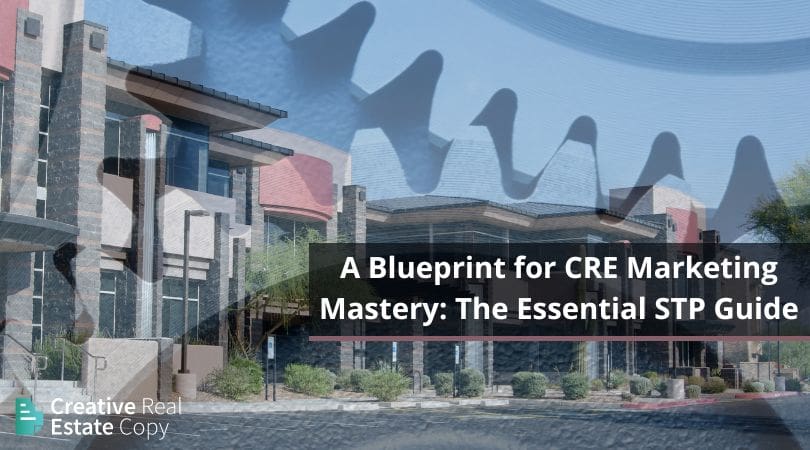In commercial real estate, aligning marketing strategies with business objectives is integral to success. The Segmentation, Targeting, Positioning (STP) marketing model offers a structured approach to identifying the most lucrative segments, focusing efforts on the most promising markets, and crafting messages that resonate with the target audience. This article explores the application of the STP model in the CRE industry, providing a roadmap for professionals looking to launch or refine their marketing strategies.
Understanding the STP Model
The STP marketing model is a strategic approach that breaks down the marketing process into three steps: Segmentation, Targeting, and Positioning. Originating from the broader marketing discipline, STP has evolved to become a cornerstone of strategic marketing, offering a framework for businesses to connect and communicate with their desired audiences more effectively.
Segmenting the CRE Market
Market segmentation involves partitioning a broad market into smaller subsets of consumers with common needs or characteristics. In CRE, effective segmentation can be based on various criteria:
- Geographic: Location-based segmentation, such as urban vs. rural areas or specific regions.
- Demographic: Based on company size, type of business, or decision-maker roles.
- Psychographic: Lifestyle or organizational culture preferences.
- Behavioral: Past purchasing behavior or property usage patterns.
Tools like market research surveys, industry reports, and analytics platforms are invaluable for identifying and understanding these segments. For instance, a CRE firm can identify a segment of tech startups looking for flexible office spaces in urban centers.
Targeting the Right CRE Segments
After segmenting the market, the next step is targeting, which involves selecting the most valuable segments to focus your marketing efforts on. This decision is based on the segment’s size, growth potential, and the competitive environment. For CRE, targeting can involve focusing on high-growth industries such as technology or healthcare, which typically need office or specialized facilities.
Positioning Your CRE Offerings
Positioning involves defining and influencing how your CRE offerings are perceived by your target audience. This includes developing a unique value proposition highlighting the benefits and differentiators of your properties or services. For a CRE firm specializing in eco-friendly buildings, positioning might emphasize sustainability and energy efficiency as key benefits that align with the values of environmentally conscious businesses.
Implementing the STP Model in CRE Marketing
Applying the STP model in CRE marketing involves several practical steps:
- Conduct intensive market research to grasp the needs and preferences of various market segments.
- Select target segments based on strategic criteria such as market potential and alignment with your firm’s strengths.
- Develop positioning strategies that highlight your unique value in meeting the needs of your target segments.
- Craft tailored marketing messages that communicate your positioning effectively to each target segment. This can involve highlighting specific features of your properties, such as location advantages, technological infrastructure, or flexible leasing terms that meet the unique requirements of your target businesses.
- Choose the appropriate marketing channels to reach your target segments. Digital marketing tactics, including SEO, content marketing, and social media, are particularly effective in CRE. For example, LinkedIn advertising might target decision-makers in specific industries, while Instagram could showcase properties’ aesthetic and functional aspects to a broader audience.
- Implement and monitor your marketing campaigns using analytics tools to measure performance against objectives. This could include tracking website traffic, engagement rates on social media, and conversion rates for inquiries or property viewings. Regular analysis helps refine your approach, ensuring your marketing efforts align with your strategic goals.
Case Study: Successful STP Strategies in CRE
Consider the case study of a CRE firm that successfully implemented the STP model by focusing on the burgeoning tech startup market. The firm targeted emerging tech companies needing flexible, innovative workspace solutions by segmenting the market based on industry and growth stage. Positioning its properties as hubs for innovation and collaboration, the firm developed targeted marketing campaigns featuring virtual tours, tenant testimonials, and flexible lease terms. The result was a significant increase in inquiries and leases from tech startups, demonstrating the effectiveness of a well-executed STP strategy.
Challenges and Considerations
While the STP model offers a robust framework for CRE marketing, professionals may encounter challenges such as accurately identifying and reaching target segments or effectively differentiating their offerings in a crowded market. Ethical considerations also play a role, particularly in ensuring marketing messages accurately reflect the features and benefits of properties or services without overselling or misrepresenting.
Opening a Pathway
The STP marketing model provides a strategic approach to refining marketing efforts in the commercial real estate sector. By effectively segmenting the market, targeting the right segments, and positioning offerings to meet the needs of these segments, CRE professionals enhance their marketing effectiveness, attract more qualified leads, and close more deals. As the CRE landscape continues to evolve, embracing the STP model offers a pathway to achieving business objectives and driving the industry forward.

